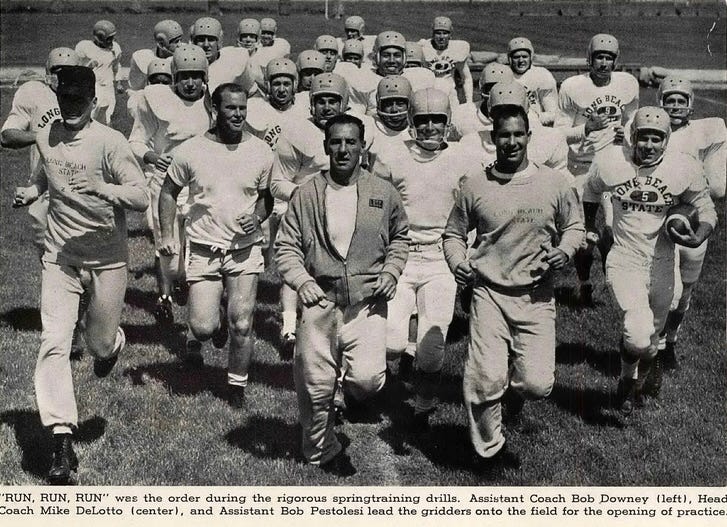Stadium Size, Football Droppers, and Deemphasizers: Long Beach State
Cal State Long Beach, commonly known as Long Beach State, was among the handful of California state schools that grew or were founded to handle the educational needs of a state whose population exploded after WWII. Over time, several of those schools faced two questions some Division I programs face today: What is the role of football and the athletic department in our institution? How much money and effort do we sink into football before giving up?
Founded in 1949, the school spent a few years getting its sea legs before playing its first football game in 1955. Their first-year schedule consisted of small private colleges and a military team or two, which remained the case for a bit before taking on a schedule of schools that looked more like them.

Long Beach State’s record was generally above .500 in those years. Their teams were filled with junior college transfers, so they tended to start the season slow and finish fast. Then, the Long Beach State 49ers and a few in-state pals caught the gold rush fever.
Athletic Director Fred Miller, later of Arizona and San Diego State, pushed them forward by helping form the Pacific Coast Athletic Association with Fresno State, San Jose State, UC Santa Barbara, and San Diego State. The conference later added Utah Sate, UNLV, Boise State, and others, eventually becoming the Big West.
The conference was the stuff dreams are made of, as the growing institutions hoped to become "big time." Shortly after the conference announcement, one columnist caught a bad cased of the fever, writing:
Can anyone envision the new Pacific Coast Athletic Association some day being larger than the Pacific Athletic Conference [later Pac-8, 10, and 12]?
Is it possible that a game between San Jose State and Los Angeles State in the PCAA might draw more people than a PAC game between Stanford and Cal?
O'Connor, Dick, 'SJS Enthused Over New Conference,' Peninsula Times Tribune (Palo Alto), January 13, 1968.
To take Long Beach State's rightful place in the athletic world, Fred Miller hired Jerry Tarkanian as basketball coach and Jim Strangeland for football. The football team won the PCAA title in 1970 and 1971, and the hoopsters reached national prominence. There was talk of building a 40,000-seat stadium so the 49ers would not need to play at Veterans Memorial Stadium, a local community facility.
Those dreams crashed in January 1974 when the NCAA placed Long Beach State's basketball and football programs on probation for recruiting violations. Nevertheless, they shifted their games to the big-time Anaheim Stadium, where they struggled to attract fans or attention and mostly played around .500 ball for the next decade. The 49ers finished the 1980s with three straight losing seasons.
Then, their dreams really did come true when George Allen agreed to coach Long Beach State. Recruiting and donations picked up as Allen willed the team to a 6-5 record, even with future Pro Football Hall of Famer Terrell Davis redshirting. However, George Allen unexpectedly passed away after the season, so they turned the reins over to Willie Brown for the 1991 season.
Unfortunately, the lack of fan support meant the program operated in deficit and ran on a smaller budget than its conference counterparts. With pending NCAA requirements that DI-A programs meet stadium and attendance targets that even the dreamers did not expect the 49ers to reach, they shut the program down following the 1991 season.
They never built that on-campus stadium, and after 1991, they didn't need it since Long Beach State decided not to spend more money on "big-time" football and would proceed without the game.
Next up: CCNY
Ranking by Stadium Size
Below are the schools reviewed to date, ranked by stadium size. The stadiums’ opening and demolition years (if applicable) are also noted.
Catholic (Brookland Stadium): 30,000 | 1924 - 1985
Denver (DU/Hilltop Stadium): 30,000 | 1925 - 1971
Marquette (Marquette Stadium): 24,000 | 1924 - 1977
Xavier (Corcoran Stadium): 15,000 | 1929 - 1988
Gonzaga (Gonzaga Stadium): 12,000 | 1922 - 1949
California State University, Fullerton (Titan Stadium): 10,000 | 1992 - TBD
Boston University (Nickerson Field): 10,000 | 1915 - TBD
Vermont (Centennial Field): 10,000 | 1923 - TBD
St. Mary’s (St. Mary’s Stadium) 5,500 | TBD
NYU (Ohio Field): 5,000 (est.) | 1897 - 1947
San Francisco (St. Ignatius Stadium): <5,000 (est.) | c. 1909 - c. 1930
Carnegie-Mellon (Skibo Bowl): 4,500 | 1960 - 1987 | Gesling Stadium: 3,900 | 1990 - TBD
Sewanee (McGee Field): 3,000 | 1891 - TBD
Long Beach State (none): 0 | Not applicable
Schools to Review
California State Santa Barbara | Case Western | Chicago | CCNY | Creighton | DePaul | Detroit | Drake | Loyola (Chicago) | Nebraska-Omaha | Pacific | St. Louis | Santa Clara | Tampa | Washington University in St. Louis | Wichita State
Click here for options on how to support this site beyond a free subscription.



George Allen died when he caught pneumonia after being given a Gatorade bath following a victory.